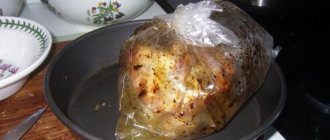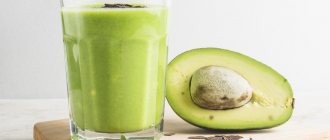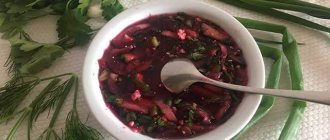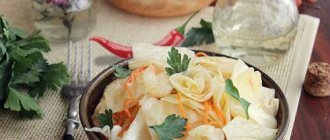Publication in the group: Vegetable dishes
Daikon, also called winter, white or Asian radish, or luobo, is especially common in Japanese, Chinese and other Asian cuisines. The root vegetable looks similar to a large, white, thick carrot and is usually eaten raw, boiled, or pickled. There are many dishes made from it, including those that include heat treatment. Most recipes with it relate to Korean, Chinese or Japanese cuisines, and have some specifics.
General principles for preparing daikon dishes
Daikon can be served raw or cooked. It is often peeled before consumption, but the skin is edible and does not need to be removed. Daikon can be cut into thin slices or half rings for a side dish or salad, chopped into cubes for heat treatment, grated for pickling, or added to baked goods and pickles.
Its greens can also be eaten raw in salads or added to soups and other hot dishes, and sprouts can be added raw to appetizers and vegetarian sushi.
Raw daikon has a sweet and slightly tangy flavor, and it tends to be milder than red radishes. The level of heat may depend on the type of vegetable, and some have a sharper, more tart flavor. Cooked daikon tastes soft and sweet, with a turnip-like consistency. The greens of the vegetable are very pungent with a sharp aroma that softens slightly when cooked.
There are 2 main types of culture - Japanese and Korean:
| Indicators | Japanese daikon | Korean daikon |
| Form | Elongated and elongated | Short and rounded |
| Taste | More tart and spicy, with a little sweetness. | Sweetish with a slight spiciness. |
| What is it best suited for? | For marinating and preparing hot dishes. | For consumption raw, light marinating and baking. |
Daikon salad
The most popular recipes for daikon dishes include various Asian salads. Most often they contain 1-2 vegetables and a dressing.
What ingredients will you need?
For the salad:
- 750 g daikon, peeled;
- 2 tbsp. l. leeks (green parts, optional), finely chopped.
For the sauce:
- 1 tbsp. l. Korean chili flakes (gochugaru), or more to taste;
- 1 tbsp. l. Korean fish sauce;
- 1 tbsp. l. sugar sand;
- 0.5 tbsp. l. grated garlic;
- 1 tsp. finely ground salt.
Step-by-step cooking process
- It is necessary to cut the daikon with a knife or vegetable peeler into thin slices. The ideal size of the pieces is thin straws 6 to 7 cm long.
- To obtain the sauce, combine all the ingredients in another container and mix until completely homogeneous.
- Next, you need to transfer the daikon into a bowl and pour in the sauce, mix everything well with your hands, sprinkle with green onions.
- Then you need to transfer the seasoned daikon into a glass container and leave for 30 minutes. into the refrigerator, then serve. If desired, you can eat the salad immediately after preparation. Leftovers can be stored in the refrigerator for 5 to 7 days.
Braised daikon
Daikon dishes, recipes for which require heat treatment, often involve stewing it with the addition of broth and meat.
What ingredients will you need?
- 1 tbsp. l. rapeseed oil;
- 2 finely chopped leeks;
- 1 tsp. chopped ginger;
- 450g ground beef (either pork, chicken or turkey);
- 2 tsp. doubanjiang (fermented spicy bean paste);
- 1 daikon (about 700 g);
- 2 tbsp. chicken or vegetable broth (can be replaced with water);
- 1 tbsp. l. soy sauce;
- 1 tbsp. l. Shaoxing wine (or sherry) (optional);
- 1 tbsp. l. sugar sand;
- 1/8 tsp. five spice powder (homemade version is better);
- 0.25 tsp sea salt, or to taste.
Step-by-step cooking process
- It is necessary to heat a thick-bottomed saucepan over low heat until hot, pour in 1 tbsp. l. oil, add leeks and ginger, cook for 1 minute. until the aroma is released.
- Next, you need to add the minced meat and cook, stirring until its surface darkens and browns.
- Then you need to add doubanjiang and stir-fry until the meat is evenly coated with seasoning.
- After this, add the daikon and continue cooking without stopping stirring everything.
- Finally, you need to pour in Shaoxing wine, chicken broth and soy sauce, add sugar and five-spice powder, heat over low heat until boiling, then turn down the heat and simmer for 15-20 minutes, or until the daikon is soft, add salt to taste .
It is recommended to serve stewed daikon with minced meat with cooked rice or separately.
Fried pork belly and daikon
This Chinese daikon dish has an interesting taste and aroma. In addition, it turns out to be quite filling and can be served as a full lunch or dinner.
What ingredients will you need?
- 200 g pork belly (pieces 5 mm thick);
- 150 g daikon;
- 1/3 Asian leek;
- 1 tbsp. l. rapeseed oil;
- 4 thin slices raw ginger;
- 2 tbsp. l. natural liquid honey;
- 300 ml Asian meat marinade;
- 1 tbsp. l. soy sauce;
- 1 tbsp. l. Manjo Hon Mirin (mirina).
Step-by-step cooking process
- It is necessary to dip the pork in the marinade and set aside for a while.
- Daikon needs to be cut into thick rectangular strips 1.5 cm wide, and long Asian leeks into small pieces.
- Vegetable oil should be heated in a frying pan, put the pork in it, draining excess liquid from it, cook on each side until golden brown, then remove and place on a plate.
- Next you need to repeat the previous step with daikon.
- Then return the brisket to the pan along with the onion, fresh ginger, honey, mirin and the remaining marinade, and simmer over moderate heat, skimming the surface, until most of the liquid has evaporated.
Baked daikon with carrots and peppers
Daikon dishes, the recipes for which are related to Chinese cuisine, are usually both sweet and slightly spicy. When mixed with other vegetables and baked in the oven, it makes a great light snack or side dish for dinner.
What ingredients will you need?
- 3 small daikons, peeled and cut into slices 5-7 mm thick;
- 4 carrots, peeled and cut into slices 5-7 mm thick;
- 1 red bell pepper, thinly sliced;
- 1 shallot, thinly sliced;
- 2 tbsp. l. olive oil;
- table salt and coarsely ground pepper;
- 0.25 tbsp. balsamic vinegar.
Step-by-step cooking process
- The oven must be preheated to 200°C.
- Daikon, carrots, red pepper, shallots and olive oil should be combined on a non-stick baking sheet, stir well, season with coarsely ground pepper and salt, bake for 25-30 minutes, stirring 1-2 times during the process.
- Next, sprinkle the vegetables with balsamic vinegar and return to the oven, bake for another 5 minutes, stir thoroughly, and then place in a serving plate and serve.
Unusual lagman recipe
This is a traditional second course of Central Asian cuisine. It is based on meat, vegetables and noodles. If you pour more liquid into the lagman, you will get a complete first course.
Ingredients:
- 0.7 kg of beef or lamb;
- 2 onions;
- 2 pcs. bell pepper;
- 1 daikon radish;
- 2 – 3 carrots;
- 200 g tomato;
- 2 cloves of garlic;
- a bunch of greenery;
- salt and spices;
- 3 tbsp. flour;
- 3 tbsp. l. vegetable oil;
- 200 ml water.
For cooking you will need a saucepan with a capacity of at least 3 liters.
Cilantro, basil, parsley, and celery are suitable as greens. Among the spices you can choose ground black and hot red pepper, cumin and coriander.
Preparation:
- Cut the meat into thin strips, onions into half rings, carrots into strips, radishes into thin bars, peppers and tomatoes into small pieces. Garlic should be passed through a press.
- Place the meat in a saucepan, add vegetable oil. Simmer until the juice evaporates. Then add onions, carrots and daikon. Add salt and spices.
- When the vegetables become soft, add pepper and garlic, and after 5 - 7 minutes. add tomatoes.
- After 5 min. stew, pour in 2 – 2.5 liters of water and cook for 25 – 30 minutes. until the meat is ready. Sprinkle the dish with chopped herbs on top.
- Make sticky noodles. Combine flour with water, add a pinch of salt. Knead the dough, grease it with vegetable oil. Leave for 10 minutes, then knead for at least 7 minutes. Roll out the workpiece into a thin layer, cut into strips 8 cm wide. Stretch and fold each strip in half, then stretch and fold in four again, repeat again. Cut strips to make thin noodles.
- Place the pieces in boiling water and cook for 2 minutes. Drain in a colander.
Place the noodles on a plate and place the stewed meat and vegetables on top. Consolidation!
Daikon with butternut squash and curry
This dish is an Indian curry that features fresh daikon and sweet Japanese pumpkin, seasoned with an aromatic spice mixture. If desired, you can add some regular or sweet potatoes.
What ingredients will you need?
For the base:
- 4 tbsp. l. melted butter or ghee;
- 1 tsp. minced or finely chopped raw ginger;
- 1 tsp. cumin seeds;
- 1 tsp. dark mustard seed;
- 0.5 tsp. fenugreek seeds;
- 8 curry leaves;
- a large pinch of asafoetida powder.
For vegetables:
- 340 g thickly chopped (0.5 cm) daikon;
- 700 g Japanese nutmeg or other yellow sweet pumpkin, peeled and cut into 2.5 cm cubes;
- 0.5 tbsp. raw or frozen peas.
For the spice mixture:
- 0.25 tsp paprika or cayenne pepper;
- 1 tsp. turmeric;
- 2 tsp. ground coriander;
- 0.25 tbsp. water;
- 0.5 tsp. amchura powder (dried mango) or 2 tbsp. l. freshly squeezed lemon juice;
- 1 tsp. salt;
- 3 tbsp. l. chopped fresh cilantro or chopped parsley.
Step-by-step cooking process
- Heat the oil in a large sauté pan over medium-high heat until it is quite hot (but not yet smoking), add the ginger, cumin, fenugreek and mustard seeds and fry until the fenugreek darkens to a golden-red color.
- Next, add the curry leaves and asafoetida (care must be taken as the curry leaves will splatter if they are fresh), a few seconds later add the daikon and fry until browned.
- Then you need to place pumpkin, peas, cayenne pepper or paprika, turmeric and coriander powder in a saucepan, add water, close the lid, turn the heat to minimum and simmer until the pumpkin is soft (20-30 minutes).
- A few minutes before serving, add amchur powder (or add lemon juice) and herbs, and add salt.
- It is recommended to serve the finished dish with rice.
Teriyaki chicken drumsticks with daikon
Daikon dishes, the recipes of which contain teriyaki sauce, are always distinguished by their pleasant sweetness and juiciness.
In this case, it is proposed to fry the vegetable along with pieces of chicken.
What ingredients will you need?
- 1/3 daikon (about 150 g);
- 8 chicken drumsticks (about 500 g);
- 3 tbsp. water;
- 3 tbsp. l. soy sauce;
- 2 tbsp. l. Sahara;
- 2 tbsp. l. mirin (sweet sake);
- 1 piece of ginger root (2-3 cm long).
Step-by-step cooking process
- It is necessary to peel and cut the daikon into round slices or, if it is large in diameter, cut it into half rings, put it in a saucepan and pour in enough water to completely cover the entire vegetable, heat to a boil.
- When the daikon is cooked, add the chicken and drain off the excess water.
- Next you need to pour 3 tbsp into the pan. water, sugar, soy sauce, mirin and chopped ginger, heat to a boil, reduce heat to medium and simmer for about 20-30 minutes, or until the chicken is cooked and the sauce has thickened.
- The next day the taste of this dish will be even better.
Salad with egg and cheese
Since daikon itself has a bright taste, all other ingredients should be softer. For this salad you will need:
- daikon (medium);
- 2 chicken eggs (boiled);
- soft cream cheese - 30 g;
- olive oil - 3 tbsp;
- freshly ground pepper and salt.
Preparation:
The daikon must be chopped into thin strips or grated, then salted and seasoned with pepper. Add grated cream cheese, sliced eggs and season with olive oil. This daikon salad with egg will decorate even a holiday table, as it has an unusual taste and freshness.
Japanese style daikon with chicken and yuzu
This dish has a unique taste and aroma as the recipe calls for mixing chicken meat with citrus fruit and fresh daikon. A mixture of sake, mirin and soy sauce makes an excellent seasoning that complements all the ingredients.
What ingredients will you need?
- 250 g chicken (pieces containing bones);
- a quarter of a medium daikon;
- zest of 1 yuzu (Japanese citrus fruit);
- 1.5 tbsp. l. soy sauce;
- 1.5 tbsp. l. Mirina (sweet rice wine);
- 1.5 tbsp. l. sake (Japanese rice wine).
Step-by-step cooking process
- You need to put the chicken pieces in boiling water, boil until half cooked, remove and rinse with water.
- Daikon should be cut into circles 3 cm wide and placed in a clean pan along with the chicken, pour in a little water, lightly covering the above ingredients, and simmer over low heat until the vegetable is soft.
- Next, you need to pour in soy sauce, mirin and sake, cover with a lid and continue cooking until the chicken and daikon are saturated with all the aromas and tastes.
- Serve the dish hot, sprinkled with small strips of yuzu zest.
Chinese soup with daikon
Chinese daikon recipes often include soups.
Daikon dishes. Chinese soup recipe.
For example, in this case it is proposed to prepare a hearty soup with pork and the specified root vegetable.
What ingredients will you need?
- 450 g pork, cut into large pieces;
- 6-8 dried shrimp;
- 2-3 dried scallops;
- 1 piece of ginger 5 cm long, cut into slices;
- 2 whole garlic cloves;
- 1 large daikon, peeled and cut into pieces;
- 3 large carrots, peeled and cut into pieces;
- 2-3 tomatoes, cut into quarters;
- table salt.
Step-by-step cooking process
- It is necessary to heat water to a boil in a large soup pot, place pieces of pork in it and cook over high heat for 10 minutes, then remove the meat and set aside.
- Drain the pan, rinse if necessary, add new clean water to make broth (about 4 liters) and add pork, shrimp, scallops, ginger and garlic, heat to a boil, then reduce heat to medium-low and cook for 30-40 minutes.
- From time to time, any fats or solids will need to be skimmed off the surface of the soup and discarded.
After the specified time, add daikon, carrots and tomatoes and cook for another 15-20 minutes, season with salt (or fish sauce) to taste.
Ingredients for making pickled daikon
- Daikon (Japanese radish, white radish) 1 kilogram
- Pure water 500 milliliters
- Turmeric 1 tablespoon
- Sugar 3–5 tablespoons
- Salt 3 teaspoons
- Vinegar 9% 2.5 tablespoons
- Garlic 3–5 cloves
- Cloves to taste
- Bay leaf to taste
- Allspice to taste
1 Prepare the daikon.
Potatoes with mushrooms in the oven: 8 recipes for cooking
Rinse the daikon thoroughly under running water, it’s best to even use a special brush. Then remove the skin from the washed root vegetables, peeling it off like carrot or potato skin. Rinse the vegetables one last time, and then wipe them dry with disposable paper towels. Use a special grater for chopping vegetables and grate the daikon
You should get very thin, translucent circles. Place the chopped daikon in a deep plate, add salt to it and stir gently but thoroughly so that every piece is salted.
2 Cook the marinade.
Pour the water into a small saucepan, add sugar, turmeric, bay leaves, cloves and allspice. Place the mixture on the fire and bring to a boil, then pour vinegar into the hot marinade and remove everything from the heat.
3 Prepare the garlic.
While the marinade is boiling, there is time to prepare the garlic cloves. They need to be peeled, cut off the ends, and then cut into thin slices.
4 Marinate the daikon.
Add garlic slices to the daikon salt and stir, then pour in the hot marinade
Mix carefully with a wooden spatula, then place a flat plate on top so that it falls in and press down with your palms. Leave the daikon in the marinade to cool at room temperature for about 1 hour.
Then move everything into the refrigerator and let it brew for 12 hours, that is, leave it for about overnight. After the radish has been pickled and turned an appetizing golden color, it can be transferred to a sterilized jar and stored in the refrigerator or served.
5 Serve the pickled daikon.
Serve pickled daikon to the table as an appetizer or as a side dish for various hot dishes prepared from fish and seafood, as well as meat or vegetables. And, as I already said, some rolls are prepared using pickled daikon, and now, instead of looking for it in the store, you can make everything at home. Bon appetit!
Tips for the recipe
– Pickled daikon will keep in the refrigerator for two weeks, so don’t be afraid to make more at once.
– Instead of regular vinegar, it is recommended to use rice vinegar, but it is quite difficult to get, because you don’t always find it in our stores.
– You can cut the daikon into thicker pieces, for example, if you don’t have a special grater, but then you should increase the time it stays in the marinade so that the radish has time to soak.
Braised daikon with orange juice
This quick and easy recipe features mildly peppery daikon simmered in fresh orange juice.
This dish is an excellent option for a healthy, low-calorie dinner.
What ingredients will you need?
- 1 large daikon, cut into slices 5-7 mm thick;
- 1.5 tbsp. strained fresh orange juice;
- 2 tsp. kosher salt;
- 1 tsp. Aleppo pepper, optional.
Step-by-step cooking process
- Place the daikon, orange juice and salt in a single layer in a frying pan, place over medium heat and cook until the liquid has evaporated under the entire surface of the vegetable.
- After about 20 min. You should carefully turn the slices over (as they will become soft and you need to try not to damage them).
- After about 10 min. you need to start continuously pouring the remaining juice over the daikon, adding it on top using a medium spoon.
- At the last minute of cooking, add pepper and then serve the dish immediately.
Fried daikon
This recipe is familiar to every housewife. Eggplants or zucchini are prepared in this way.
- Mix flour with salt and pepper.
- Roll the daikon, cut into slices up to half a centimeter thick, in flour.
- Dip the circle into the beaten egg.
- Bread in ground breadcrumbs and place on a hot greased frying pan.
- Fry on both sides for 4-5 minutes.
- Place on a napkin to remove excess oil.
- Serve hot with sour cream, mayonnaise or other sauce.
Pie with daikon in a steamer
Steamed daikon cake is known in Chinese cuisine as Lo Bak Gou.
This is one of the most common dishes of this type available for home preparation.
What ingredients will you need?
For filling:
- 400-500 g chopped daikon;
- 1 small grated carrot (about 0.5 tbsp.);
- 1 tbsp. fresh mung bean sprouts;
- 0.25 tbsp. chopped Chinese garlic;
- 1 tbsp. l. canned Asian radish (takuana);
- 1 tsp. regular garlic;
- 2 tsp. sambal oelek, optional;
- 1 tbsp. l. soy sauce, gluten-free if necessary;
- a few white peppercorns;
- cooking oil;
- table salt to your own taste.
For the test:
- 1 tbsp. (210 g) rice flour;
- 2 tbsp. water brought to room temperature;
- 1 tsp. table salt;
- 1 tsp. freshly ground pepper.
Step-by-step cooking process
- Chop the daikon and carrots in a deep bowl and set aside.
- To prepare the batter, combine flour, water and 1 tsp in another bowl. salt and whisk until everything is combined.
- In a preheated non-stick frying pan, cook the chopped daikon and carrots until the daikon becomes translucent and all the liquid has evaporated (over low heat).
- Next, reduce the heat to low, add the dough and continue cooking, stirring constantly, until the mixture thickens. The entire daikon should be covered in batter. At this stage, you need to season the dishes with pepper and salt.
- Then you need to transfer the mixture to a non-stick baking tray and cover with foil if necessary.
- Place the filled pan on the inner rack of the steamer and cook over high heat for about 30 minutes, or until a cake tester (or inserted fork) comes out clean.
- The finished cake should be allowed to cool completely or even refrigerated overnight before cutting.
If desired, the cooled pie can be further fried:
- You need to remove the product from the mold, picking it up along the edges with a sharp thin knife, and transfer it to a clean cutting board, cut into small cubes.
- In a preheated frying pan with a non-stick coating and a small amount of oil, fry the pieces until golden brown on all sides, transfer to a clean bowl.
- Add a little more oil to the same pan and fry the garlic and canned radishes until intensely fragrant, then add the chili sauce (if using, for a spicy version).
- Next, you need to put the cake cubes back into the mold and season with soy sauce.
- Finally, you need to add the vegetables and stir, cook in a double boiler for about 10 minutes, or until the vegetables become a little soft.
- Serve warm with chili sauce or without additional additives.
Recipe: Pickled daikon | We pickle daikon for the winter. Cooking secrets.
Ingredients:
daikon – 800 gr; apple cider vinegar – 50 ml; rice vinegar – 50 ml; turmeric – 1 teaspoon; lemon zest - from one lemon; garlic – 2 heads; Korean carrot seasoning – 1 tbsp; salt – 1.5 tablespoons; granulated sugar – 2 tablespoons; filtered water – 100 ml Good day to you
I noticed that there is very little information on the Internet about how to cook daikon. And when I typed “daikon recipes” I found very few of those same recipes
Meanwhile, in the cuisines of eastern countries such as Korea, Japan, and China, this root vegetable occupies almost the first place. Well, let’s gradually correct this shortcoming and start with a recipe for a dish called “Marinated Daikon.” The dish is very simple to prepare, but after trying it at least once, you can say that you will immediately fall in love with its unforgettable taste. And to prepare such a not only tasty but also very beautiful snack
You and I will need these ingredients, the exact quantities of which you can read at the top of this recipe.
1. First, as usual, you need to prepare all the ingredients. You need to take fresh daikon, make sure that it is not soft and dried out. Otherwise, the inside becomes like a coarse sponge and is not suitable for any dish. Wash the daikon and peel off the top layer, leaving white, hard pulp.
2. If the daikon is not very large and thick, then cut it into thin circles, and if you got a large specimen, then cut these circles into two or four parts.
3. In order to remove excess moisture from the daikon and the slight bitterness present in this root vegetable, sprinkle the cut daikon circles with salt and allow the liquid to drain. To do this, I placed the daikon on a sieve.
Next, peel the garlic cloves and cut it into large pieces, and also thinly remove the lemon zest. Garlic will give a slight and pleasant pungency and aroma, and the essential oils of lemon zest will add a pleasant citrus note to the taste of this dish.
Well, now let's get to the vinegar. Pour 50 grams of rice vinegar and 50 grams of apple cider vinegar into a regular glass. Next, fill the glass with filtered or boiled cooled water almost to the top.
Add to our mixture of vinegars and water a tablespoon of Korean carrot spices, a heaping teaspoon of turmeric and two tablespoons of granulated sugar and mix it all thoroughly until the sugar dissolves.
Next, place the daikon slices in layers in a plastic or glass bowl with a lid. Between the layers of daikon, lay out layers of garlic, cut into slices and sprinkle with lemon zest. I also lightly sprinkled some turmeric between the layers of daikon so that the color of the daikon becomes a beautiful golden yellow when marinated.
If you don’t have Korean carrot spices on hand, simply add thinly sliced red hot pepper rings, a little ground coriander and paprika to the layers of garlic and lemon zest.
Then pour our marinade onto the layered daikon and press lightly so that the marinade is evenly distributed.
Next, cover the dish with a lid and put it in the refrigerator for two days. In this marinade, daikon can be stored in the refrigerator for quite a long time (for me it usually does not last longer than three weeks)).
In two days you can already enjoy this wonderful dish. The taste of this snack is so pleasant that it becomes very difficult to stop once you have already started trying it. It’s true that my relatives sometimes can’t stand these two days and start trying the very next day, saying that the dish is already ready, but believe me, since the daikin root vegetable is still quite hard, it needs more time to marinate than other vegetables, it is better to wait and marinate it. But at the end, a dish that is delicious in both color and taste will await you. And most importantly, daikon does not lose its beneficial properties during such processing.
This appetizer will very well complement and decorate any table, both daily and festive, and will beneficially diversify any menu! It can be used as a filling for sushi and rolls, and as an additional side dish instead of salted or pickled cucumbers.
I indicated the cooking time without taking into account marinating in the refrigerator.
And finally, as always, I wish you bon appetit and creative culinary success.
Cooking time: PT00h30M20 min.
Is this a good recipe?
fotorecept.com
Useful tips and tricks
Basic useful tips and tricks regarding cooking daikon are as follows:
- Daikon is available in many supermarkets, especially larger ones with Asian food sections. It is a seasonal product in winter, and often appears on markets in late autumn or early winter.
- Depending on the variety and variety, daikon can have a length from 20 to 50-60 cm. Some root vegetables have a round rather than elongated shape.
- Regardless of the variety of daikon, you should look for a vegetable that has a firm skin, is heavy for its size, and has no cuts or dark or soft spots.
- In addition, you can grow the root vegetable at home. To do this, you will need to plant the seeds in summer or early autumn (depending on the growing zone) to obtain a winter harvest (or get a ripe vegetable about 2 months before the first frost). This plant is often used in agriculture as a soil tillage because it leaves a cavity for crops such as potatoes to be planted in and adds nutrients to the soil.
- If the purchased daikon has leaves, it is recommended to pick them and store them separately. The unwashed root is stored for 1-2 weeks in a plastic bag in the refrigerator, the leaves for up to 3 days.
- Sliced raw daikon can be stored in the refrigerator for a long time, but it can emit a strong odor that can be absorbed by other foods nearby.
- Blanched root vegetables can be frozen for up to 1 month, and cooked ones can be stored in an airtight container in the refrigerator for several days. Pickled daikon can be stored for 3 weeks or more.
- Daikon is very low in calories (only 18 calories per 100 g) and almost completely fat-free. At the same time, the root vegetable is a good source of vitamin C, containing 24% of the recommended daily intake of this compound.
- Raw daikon roots, leaves and sprouts are used in salads and as a side dish. The root vegetable is often used to make crispy and mildly spicy pickles, including Japanese takuan and bettarazuke. Daikon, grated and marinated with carrots, is a common filling for Vietnamese banh mi sandwiches.
- It is not necessary to peel the daikon, but if you do, you will need to wash it very thoroughly.
- It is recommended to use a special vegetable cutter to cut the pieces evenly and reduce the time for preparing the product.
- It should be noted that different flavors are combined in one root: the part closest to the leaves is considered the sweetest, while the end of the vegetable has the most pungency, and the middle combines sweetness and tartness.
If daikon is not commercially available, you can use any other variety of radish to prepare any recipes that call for it.
Daikon radish - beneficial properties and contraindications of the root vegetable
What to cook with pumpkin: 7 very tasty and healthy dishes
A huge amount of valuable substances allows the root vegetable to be used for various diseases. But the therapeutic effect can only be achieved with long-term use.
Medicinal properties:
- Antiseptic.
- Strengthening.
- Anti-inflammatory.
- Regenerating.
- Antivirus.
- Whitening.
1. Thanks to the content of fiber and pectin, the functioning of the gastrointestinal tract improves.
2. As a result of consumption, the intestines are cleansed, waste and toxins are removed.
3. Removes harmful cholesterol.
4. Normalizes blood pressure, allows you to restore potassium reserves in the body.
5. Cope with insomnia, helps strengthen the nervous system, thanks to the presence of B vitamins.
6. Used to prevent diabetes.
7. The pulp and juice can be used as a diuretic and laxative.
8. Juice helps digestion processes and the formation of a sufficient amount of bile.
Vitamins:
Let's take a closer look at the vitamins and microelements contained in radish:
- Potassium
- Calcium
- Sodium
- Iron
- Iodine
- Selenium
- Copper
Contains B vitamins, vitamin A, C and PP, N.
- Pectin
- Cellulose
- Enzymes
- Carotene
- Fructose
- Antioxidants
Important! A large number of antioxidants contained in radish effectively fight atherosclerosis, cardiovascular diseases and the processes of premature aging of the body. The product can be included in the diet of people who lead a healthy lifestyle and prefer proper nutrition, as well as those who want to normalize their weight
The product can be included in the diet of people who lead a healthy lifestyle and prefer proper nutrition, as well as those who want to normalize their weight.
Calories:
The calorie content is scanty, only 21 kcal per 100 grams of product.
A large vegetable, depending on the variety, it can weigh from 5 kg. up to 20 kg. These are record breakers!
Having learned about the beneficial properties of daikon, you will definitely want to grow the vegetable in your own garden. But, having familiarized yourself with the benefits, do not forget to read the contraindications
It is very important
Useful properties of daikon radish:
Radish is included in the diet due to its extreme benefits for the body. Considering the beneficial properties of Japanese daikon radish, we can highlight:
1. Cleansing the body. Removal of fluid, cleansing of the intestines, cleansing the body, use as a diuretic and laxative.
2. Strengthening the immune system. Thanks to its excellent composition, regular use strengthens the immune system.
3. Prevention and treatment of diabetes. Eating radish helps normalize blood sugar.
4. Cleansing the liver and kidneys. Eating daikon and drinking radish juice every day can improve kidney and liver function.
5. Treatment of heart and vascular diseases. Used as food for various diseases of the cardiovascular system, helps prevent atherosclerosis.
6. Improvement of scalp and hair. Juice rubbed into hair roots nourishes and strengthens hair.
7. Weight loss. Radish juice and pulp helps you lose weight quickly and harmlessly. Helps cleanse the body, so feel free to use it in your diet.
8. Strengthening the nervous system. Radish juice strengthens the nervous system. Drinking juice at night will make your sleep healthier and more sound.
9. Skin treatment. Cleanses the skin of freckles, age spots, whitens, is used to fight acne, and removes inflammation.
10. Prevention of cancer. It is an effective means of prevention.
11. Increases appetite. The vegetable helps increase appetite.
There is even an opinion that 200 grams of grated radish helps to cope with a hangover. I personally have not tested this product.
Having understood the benefits of radish, let's look at what contraindications daikon has. I always emphasize that all vegetables, berries, and fruits are consumed in moderation; you should not eat too much
It is important to know when to stop
Contraindications:
Radish should be used with caution for kidney stones and gall bladder stones. The vegetable promotes the resorption of stones, but can also provoke their release
The vegetable can cause skin allergies or irritation.
If consumed in excess, it may cause flatulence.
In case of exacerbation of peptic ulcer or gastritis,











